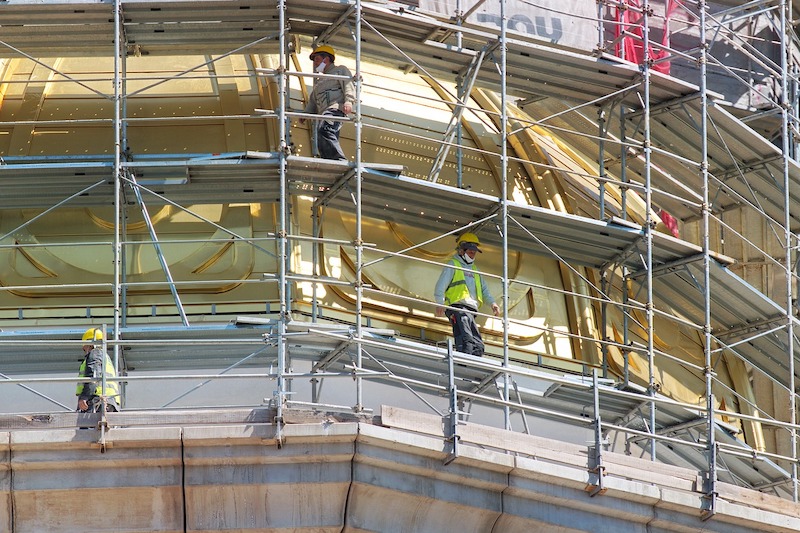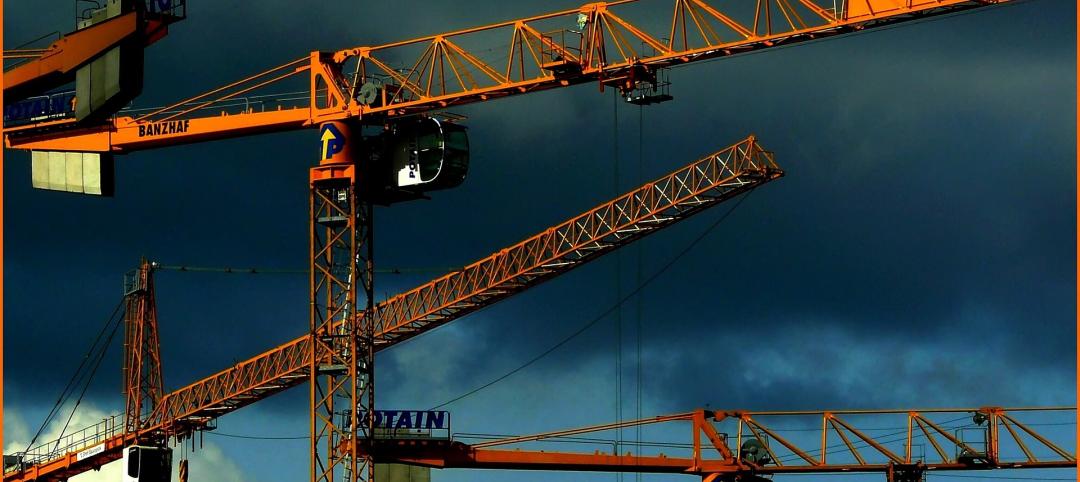The Q2 2020 USG Corporation + U.S. Chamber of Commerce Commercial Construction Index (Index) released today plunged from 74 in Q1 to 56 in Q2. Two of the index’s three main indicators—confidence in new business and revenue expectations—both fell 26 points, to 50 and 44, respectively, revealing the severe impact of the coronavirus pandemic on the construction industry. However, the third indicator, backlog, dropped only a modest three points, remaining consistent with the first half of 2018. Survey results were largely collected in the month of April, at the height of shutdown restrictions.
The overall drop in the Index stemmed in part from the fact that very few contractors (16%) now express high confidence in the market’s ability to provide new business opportunities in the next 12 months (down from 54% in Q1), and there was a 30 percentage point drop in contractors expecting their revenues to increase (17% in Q2 from 47% in Q1). Meanwhile, the percentage expecting to see their revenues decrease in the next 12 months spiked from 2% in Q1 to 21% in Q2.
Yet several survey findings suggest that the commercial construction industry is poised for recovery. Contractors still have significant backlog, with 60% of contractors reporting they have at least six months of backlog (compared to 69% in Q1). More than eight in 10 (83%) say their revenue will increase or remain about the same in the next year. And, three in four contractors say they have moderate or high confidence that the next year will bring sufficient new business opportunities (and in the next two years, that percentage rises to 93%).
This quarter’s Index also reveals that the commercial construction industry is an important employer and is ready to hire more workers. One in three contractors (32%) plan to hire more workers in the next six months, while nearly half (48%) believe their workforce will stay the same. Only 15% expect to employ fewer people.
“Even as most construction has been deemed essential during the last few months, the loss of new projects and revenue has been severe. This industry is key to our economy, representing three million American jobs and $700 billion in spending," says Christopher Griffin, president and CEO of USG Corporation. “We’re watching closely signs of improvement, as commercial construction can serve as a bellwether for other economic development and recovery.”
Covid-19 Impacts
When the survey was taken in April 2020 the vast majority (87%) of contractors reported they were currently experiencing delays due to the coronavirus outbreak, with 87% expecting delays to continue into the summer and 73% expecting delays will remain in the fall.
However, contractors become less concerned about delayed projects as they look to the future. In April, over a third (35%) of contractors reported that at least 75% of their projects were delayed. Asked to look three months ahead, only 16% of contractors expected the same, and looking six months ahead, only 8% expect at least 75% of their projects to be delayed.
“No industry has been immune to the devastating impact of Covid-19,” said Neil Bradley, U.S. Chamber of Commerce executive vice president and chief policy officer. “However, the commercial construction industry appears poised for a quick recovery and a return to growth. This is good news for the economy and the millions of Americans who work in the industry. Congress can help by continuing to support the economy.”
Contractors quickly adapted their operations to comply with new safety guidelines. More than nine in 10 contractors (92%) said they changed work procedures to increase social distancing. And, contractors indicated worker health and safety is top of mind. Given a list to choose from of the most severe Covid-19 consequences for their business, three-quarters (75%) said worker health and safety is a top concern, followed by fewer projects (48%), and increases in workforce shortages (33%).
Asked how the pandemic will change how they do business in the future, contractors said adjustments to safety and work procedures would be the top change. They also expect big changes in more remote work for their staff and paying greater attention to language used in contracts.
On June 24, join USG Corporation and the U.S. Chamber of Commerce for a virtual panel discussion on Covid-19’s impact on the construction industry, where USG Corporation CEO Chris Griffin, U.S. Chamber of Commerce Senior Economist Curtis Dubay, and Association of the Wall and Ceiling Industry CEO Michael Stark will discuss these survey findings and more.
The Index is comprised of three leading indicators to gauge confidence in the commercial construction industry, generating a composite Index on the scale of 0 to 100 that serves as an indicator of health of the contractor segment on a quarterly basis. The survey was in the field April 4 - 27, 2020.
The Q2 2020 results from the three key drivers were:
- Backlog: The backlog indicator dropped three points to 73 (from 76 in Q1).
- New Business Confidence: The overall level of contractor confidence dropped to 50 (down 26 points from Q1).
- Revenue: Contractors’ revenue expectations over the next 12 months dropped to 44 (down 26 points from Q1).
The research was developed with Dodge Data & Analytics (DD&A), the leading provider of insights and data for the construction industry, by surveying commercial and institutional contractors.
Related Stories
Market Data | Sep 5, 2023
Nonresidential construction spending increased 0.1% in July 2023
National nonresidential construction spending grew 0.1% in July, according to an Associated Builders and Contractors analysis of data published today by the U.S. Census Bureau. On a seasonally adjusted annualized basis, nonresidential spending totaled $1.08 trillion and is up 16.5% year over year.
Giants 400 | Aug 31, 2023
Top 35 Engineering Architecture Firms for 2023
Jacobs, AECOM, Alfa Tech, Burns & McDonnell, and Ramboll top the rankings of the nation's largest engineering architecture (EA) firms for nonresidential buildings and multifamily buildings work, as reported in Building Design+Construction's 2023 Giants 400 Report.
Giants 400 | Aug 22, 2023
Top 115 Architecture Engineering Firms for 2023
Stantec, HDR, Page, HOK, and Arcadis North America top the rankings of the nation's largest architecture engineering (AE) firms for nonresidential building and multifamily housing work, as reported in Building Design+Construction's 2023 Giants 400 Report.
Giants 400 | Aug 22, 2023
2023 Giants 400 Report: Ranking the nation's largest architecture, engineering, and construction firms
A record 552 AEC firms submitted data for BD+C's 2023 Giants 400 Report. The final report includes 137 rankings across 25 building sectors and specialty categories.
Giants 400 | Aug 22, 2023
Top 175 Architecture Firms for 2023
Gensler, HKS, Perkins&Will, Corgan, and Perkins Eastman top the rankings of the nation's largest architecture firms for nonresidential building and multifamily housing work, as reported in Building Design+Construction's 2023 Giants 400 Report.
Apartments | Aug 22, 2023
Key takeaways from RCLCO's 2023 apartment renter preferences study
Gregg Logan, Managing Director of real estate consulting firm RCLCO, reveals the highlights of RCLCO's new research study, “2023 Rental Consumer Preferences Report.” Logan speaks with BD+C's Robert Cassidy.
Market Data | Aug 18, 2023
Construction soldiers on, despite rising materials and labor costs
Quarterly analyses from Skanska, Mortenson, and Gordian show nonresidential building still subject to materials and labor volatility, and regional disparities.
Apartments | Aug 14, 2023
Yardi Matrix updates near-term multifamily supply forecast
The multifamily housing supply could increase by up to nearly 7% by the end of 2023, states the latest Multifamily Supply Forecast from Yardi Matrix.
Hotel Facilities | Aug 2, 2023
Top 5 markets for hotel construction
According to the United States Construction Pipeline Trend Report by Lodging Econometrics (LE) for Q2 2023, the five markets with the largest hotel construction pipelines are Dallas with a record-high 184 projects/21,501 rooms, Atlanta with 141 projects/17,993 rooms, Phoenix with 119 projects/16,107 rooms, Nashville with 116 projects/15,346 rooms, and Los Angeles with 112 projects/17,797 rooms.
Market Data | Aug 1, 2023
Nonresidential construction spending increases slightly in June
National nonresidential construction spending increased 0.1% in June, according to an Associated Builders and Contractors analysis of data published today by the U.S. Census Bureau. Spending is up 18% over the past 12 months. On a seasonally adjusted annualized basis, nonresidential spending totaled $1.07 trillion in June.

















